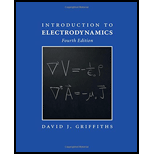
(a) Let
(b) Show that
Learn your wayIncludes step-by-step video

Chapter 1 Solutions
Introduction to Electrodynamics
Additional Science Textbook Solutions
Physics for Scientists and Engineers: A Strategic Approach with Modern Physics (4th Edition)
Cosmic Perspective Fundamentals
University Physics with Modern Physics (14th Edition)
Applied Physics (11th Edition)
The Cosmic Perspective Fundamentals (2nd Edition)
College Physics (10th Edition)
- (0,0,0) and the 5. The point o is the origin of the coordinate system, o = coordinates of b are b = (x,y, z). The electric potential at o is zero, V, = 0. Hence, the electric potential at b is V = – E · dr. You can take any path from o to b. (a) Here is one particular path from o to b. First move on a straight line from o to a = : (x,0,0), then from a to a' = (x, Y, 0), and finally from a' to b = (x, y, z). Make a plot of this path, indicating the coordinate system and the locations of a, a' and b. – SE • dr depends only on the y However, the line integral V coordinate of b = (x, y, z). Hence, in the following, we will focus on b = (0, y, 0) and take the straight path from o to b. (b) Compute E · dr for y d result, use this potential next.arrow_forwardDetermine whether the vector field is conservative and, if so, find the general potential function. F=⟨cos(z),2y^3,−xsin(z)⟩arrow_forward3. Given the following scalar potentials (V), calculate the solution for the gradient of V (VV), and plot the vector arrow representation of this vector field over the given limits. (a) V = 15 + r cos o, for 0 < r < 10, and 0 < $ < 2n. (b) V = 100 + xy, for –10 < x < 10,arrow_forward
- X = 2ax(y³ + z³), Y= 2ay(y³ + z³) + 3ay²(x² +y²) , Z = 3az² (x² + y?) Examine whether the force field is conservative, and if conservative, find its potential.arrow_forwardA sphere of radius a has potential (sin 2θ)( cos ϕ) on its surface. Find the potential at all points outside the sphere.arrow_forwardIf V (x, y) is the electric potential at a point (x, y) of the xy plane, then the level curves of V are called equipotential curves, so that at all points on this curve the electric potential is the same. Find the range of V and the level curves of the following function:arrow_forward
- When two charges of the same sign and magnitude are at the adjacent vertices of a square, the electric potential at the center of the square is V. What is the electric force on the charge of the same magnitude and sign positioned at the center of the opposite side, at point P, in addition to the two original charges? Draw the electric force vectors and express your answer in term of V and k. □arrow_forwardQ3/ a) given that the potential v = (2x²y + 2xy²z²)mv 1) Find E at (1,2,3) 2) Py c/m³ b) point p and Q are located at P(1,2,3) and Q(3,2,1) find the vector parallel to PQ with magnitude of 5cm.arrow_forwardConsider the following potential V(x) = 3x2 + 4.x + 3. The equilibrium and it is a position is located at equilibriumarrow_forward
 Classical Dynamics of Particles and SystemsPhysicsISBN:9780534408961Author:Stephen T. Thornton, Jerry B. MarionPublisher:Cengage Learning
Classical Dynamics of Particles and SystemsPhysicsISBN:9780534408961Author:Stephen T. Thornton, Jerry B. MarionPublisher:Cengage Learning
